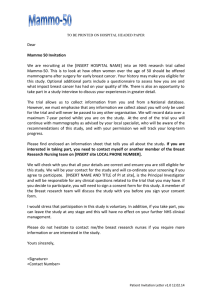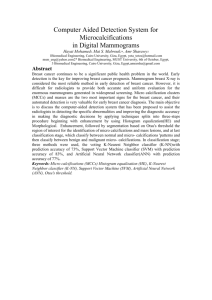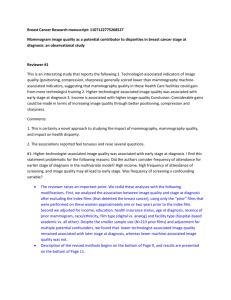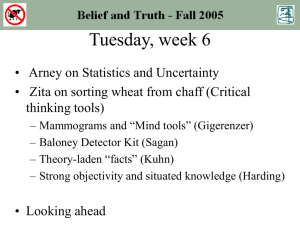Research Journal of Applied Sciences, Engineering and Technology 4(24): 5480-5483,... ISSN: 2040-7467
advertisement
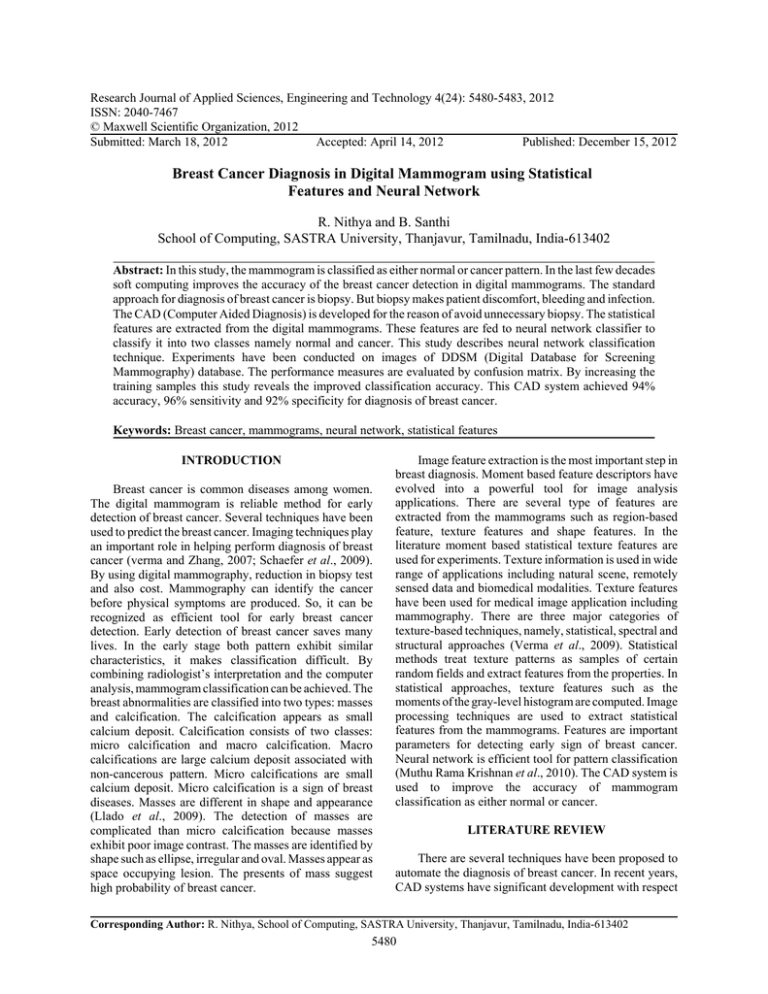
Research Journal of Applied Sciences, Engineering and Technology 4(24): 5480-5483, 2012 ISSN: 2040-7467 © Maxwell Scientific Organization, 2012 Submitted: March 18, 2012 Accepted: April 14, 2012 Published: December 15, 2012 Breast Cancer Diagnosis in Digital Mammogram using Statistical Features and Neural Network R. Nithya and B. Santhi School of Computing, SASTRA University, Thanjavur, Tamilnadu, India-613402 Abstract: In this study, the mammogram is classified as either normal or cancer pattern. In the last few decades soft computing improves the accuracy of the breast cancer detection in digital mammograms. The standard approach for diagnosis of breast cancer is biopsy. But biopsy makes patient discomfort, bleeding and infection. The CAD (Computer Aided Diagnosis) is developed for the reason of avoid unnecessary biopsy. The statistical features are extracted from the digital mammograms. These features are fed to neural network classifier to classify it into two classes namely normal and cancer. This study describes neural network classification technique. Experiments have been conducted on images of DDSM (Digital Database for Screening Mammography) database. The performance measures are evaluated by confusion matrix. By increasing the training samples this study reveals the improved classification accuracy. This CAD system achieved 94% accuracy, 96% sensitivity and 92% specificity for diagnosis of breast cancer. Keywords: Breast cancer, mammograms, neural network, statistical features INTRODUCTION Breast cancer is common diseases among women. The digital mammogram is reliable method for early detection of breast cancer. Several techniques have been used to predict the breast cancer. Imaging techniques play an important role in helping perform diagnosis of breast cancer (verma and Zhang, 2007; Schaefer et al., 2009). By using digital mammography, reduction in biopsy test and also cost. Mammography can identify the cancer before physical symptoms are produced. So, it can be recognized as efficient tool for early breast cancer detection. Early detection of breast cancer saves many lives. In the early stage both pattern exhibit similar characteristics, it makes classification difficult. By combining radiologist’s interpretation and the computer analysis, mammogram classification can be achieved. The breast abnormalities are classified into two types: masses and calcification. The calcification appears as small calcium deposit. Calcification consists of two classes: micro calcification and macro calcification. Macro calcifications are large calcium deposit associated with non-cancerous pattern. Micro calcifications are small calcium deposit. Micro calcification is a sign of breast diseases. Masses are different in shape and appearance (Llado et al., 2009). The detection of masses are complicated than micro calcification because masses exhibit poor image contrast. The masses are identified by shape such as ellipse, irregular and oval. Masses appear as space occupying lesion. The presents of mass suggest high probability of breast cancer. Image feature extraction is the most important step in breast diagnosis. Moment based feature descriptors have evolved into a powerful tool for image analysis applications. There are several type of features are extracted from the mammograms such as region-based feature, texture features and shape features. In the literature moment based statistical texture features are used for experiments. Texture information is used in wide range of applications including natural scene, remotely sensed data and biomedical modalities. Texture features have been used for medical image application including mammography. There are three major categories of texture-based techniques, namely, statistical, spectral and structural approaches (Verma et al., 2009). Statistical methods treat texture patterns as samples of certain random fields and extract features from the properties. In statistical approaches, texture features such as the moments of the gray-level histogram are computed. Image processing techniques are used to extract statistical features from the mammograms. Features are important parameters for detecting early sign of breast cancer. Neural network is efficient tool for pattern classification (Muthu Rama Krishnan et al., 2010). The CAD system is used to improve the accuracy of mammogram classification as either normal or cancer. LITERATURE REVIEW There are several techniques have been proposed to automate the diagnosis of breast cancer. In recent years, CAD systems have significant development with respect Corresponding Author: R. Nithya, School of Computing, SASTRA University, Thanjavur, Tamilnadu, India-613402 5480 Res. J. Appl. Sci. Eng. Technol., 4(24): 5480-5483, 2012 to automated detection and classification of breast abnormality in digital mammograms. The CAD system is used for the purpose of pattern classification. Verma and Zhang (2007) proposed a novel neural-genetic algorithm to find the most significant combination of features in digital mammograms. The highest classification rate achieved for testing set was 85% on mammograms from the DDSM. Schaefer et al. (2009) used thermography based breast cancer analysis using statistical features and fuzzy classification. Experimental results on large dataset of nearly 150 cases confirm the efficacy of the approach that provides a classification accuracy of about 80%. Llado et al. (2009) proposed textural approach and obtained subsequent reduction in false positive rate .Their approach is evaluated using 1792 ROIs extracted from the DDSM. Verma et al. (2009) proposed a novel soft cluster neural network. The highest classification accuracy obtained by this approach was 93% on mammograms from the DDSM. Muthu Rama Krishnan et al. (2010) used statistical features with support vector machine and accuracy obtained was 93.24% on Wisconsin Diagnosis Breast Cancer (WDBC) dataset. MATERIALS AND METHODS An overview of research methodology for classification of normal and cancer pattern is given in Fig. 1 and it involves data collection, feature extraction, neural network training and testing. Table 1: Formulae for statistical moment Moment Fig. 1: An overview of research methodology Image dataset: The digital mammograms used for this experiment obtained from DDSM and it was downloaded from the http:// marathon. csee.usf. edu/ Mammography/ DDSM. The total 250 mammograms were utilized for training and testing (125 normal and 125 cancer). Feature extraction: Texture analysis is based on statistical properties of the intensity histogram moments. The image histogram contains information about the content of image. Grey level based features like average intensity, average contrast, smoothness, third moment, uniformity and entropy extracted from the digital mammograms. The formulae for every feature are shown in Table 1. For each of the formulae: zi is a random variable indicating intensity, p(zi) is the histogram of intensity levels in a region, L is the number of possible intensity levels and ‘m’ is the mean (average) intensity. These features are as shown in Table 2. Expressio = ∑ Measure of texture L −1 z p(zi) Average intensity Mean m Standard deviation F= Smoothness R = 1− Third moment µ3 = ∑ Uniformity U= ∑ Entropy e = − ∑ i = 0 p (zi) log2 p(zi) i=0 i i µ2 ( z ) = σ 2 Average contrast 1 1+ σ 2 L −1 i=0 Smoothness of intensity in a histogram. p (zi-m)3p(zi) L −1 i=0 p2 Skewness of the histogram (zi) Uniformity of intensity in the histogram L −1 Table 2: Statistical features for the mammogram images Image id Image class Average intensity Mam1 Normal 69.5967 Mam2 Normal 73.67541 Mam3 Normal 60.60543 Mam4 Normal 36.19452 Mam5 Normal 68.68612 Mam6 Cancer 50.08544 Mam7 Cancer 50.32452 Mam8 Cancer 37.02695 Mam9 Cancer 49.29640 Mam10 Cancer 67.23113 Average contrast 35.11347 30.29273 32.32825 41.98268 43.03107 49.18930 29.32724 42.77781 36.43984 31.05172 5481 Smoothness 0.01861 0.01392 0.01582 0.02639 0.02769 0.03588 0.01305 0.02732 0.02001 0.01461 A measure of randomness Third moment -0.07705 -0.21687 -0.01065 0.77714 -0.07939 0.26286 -0.11470 0.78444 0.57828 -0.11765 Uniformity 0.07059 0.03016 0.09455 0.20963 0.03865 0.18727 0.23603 0.05047 0.04239 0.04448 Entropy 5.59239 6.19349 5.66164 4.65060 5.97751 4.70950 4.19086 5.62079 5.70384 6.04602 Res. J. Appl. Sci. Eng. Technol., 4(24): 5480-5483, 2012 Classification-neural classifier: Neural classifier is processed in two phases namely training phase and testing phase. In training phase, weights are updated. The supervised training phase is based on the backpropagation algorithm. In testing phase, mammograms are classified based on this updated weight. The neural classifier consists of three layers such as input, hidden and output layer. The sigmoid activation function is used for both hidden layer and output layer (keles et al., 2011; Buciu and Gacsadi, 2010). The weights between input and hidden layer and the weights between hidden layer and output of neural network are updated to achieve optimum classification (Delogu et al., 2007; Vasantha et al., 2010). The updated weight value will improve the overall classification accuracy. The results are based on initial weight value. In feature extraction phase, six features are computed. Among these features four relevant features are identified including third moment, entropy, smoothness and uniformity. The identified features are fed to input layer. The output layer produces classification of mammograms either normal or cancer. Training algorithm: Step 1: Extract features from mammograms Step 2: Create input and desired output for normal pattern Step 3: Create input and desired output for cancer pattern Step 4: Initialize weights and activation function. Step 5: Compute error Step 6: Update weight Testing algorithm: Step 1: Extract features from mammograms Step 2: Create input for normal pattern Step 3: Create input for cancer pattern Step 4: Calculate output Performance measure: The performance of this system is evaluated based on the experiments such as classification accuracy, sensitivity and specificity are calculated using confusion matrix (verma et al., 2009). These measures are associated with binary classification and they evaluate performance of a test. In binary classification divide dataset into two categories. Sensitivity measures how well the test predicts one category (Burak Tosuna et al., 2009). Specificity measures how well the test predicts the other category. Accuracy is evaluated using sensitivity and specificity: Classification accuracy = (TP+TN) / (TP+FP+TN+FN) Sensitivity = TP/ (TP+FN) Specificity = TN/ (TN+FP) Where TN: True Negative (correct normal diagnosis)'; FN: False Negative (incorrect normal diagnosis); TP: True Positive (correct cancer diagnosis); FP: False Positive (incorrect cancer diagnosis). EXPERIMENTAL RESULTS This study conduct experiments on a set of 250 mammograms obtained from DDSM database. The experiments were run using 200 mammograms (100 normal, 100 cancer) for training and 50 mammograms (25 normal, 25 cancer) were used for testing. In the first stage of this experiment is conducted to extract statistical features from the mammograms. In the second stage, the extracted features are fed into neural network classifier. The neural classifier classifies the images as normal image or cancer image. The number of hidden units and output threshold were adjusted to achieve optimum classification. The experiments were performed by changing the number of training samples and the results are reported. For testing accuracy of the classifier, 50 mammograms are tested by a different number of training samples such as 70% (140 out of 200), 80% (160 out of 200) and 90% (180 out of 200). Classification results are displayed using confusion matrix in Table 3 to 5 details the performance of different training samples for the classification of normal and cancer patterns in digital mammograms. The training sample 90% shows the best result. In Fig. 2, comparisons of performance measures are depicted. Performance measures are shown in Table 6. Table 3: Confusion matrix (training data -70%; testing data -50) Predicted ----------------------------------------------Actual cancer (positive) normal (negative) Cancer (positive) 24 (TP) 1 (FP) Normal (negative) 6 (FN) 19 (TN) Table 4: Confusion matrix (training data -80%; testing data -50) Predicted ----------------------------------------------Actual cancer (positive) normal (negative) Cancer (positive) 24 (TP) 1 (FP) Normal (negative) 5 (FN) 20 (TN) Table 5: Confusion matrix (training data -90%; testing data -50) Predicted ----------------------------------------------Actual cancer (positive) normal (negative) Cancer (positive) 23 (TP) 2 (FP) Normal (negative) 1 (FN) 24 (TN) Table 6: Accuracy, sensitivity and specificity for testing result Performance measure (%) 70% training 80% training 90% training Accuracy 86 88 94 Sensitivity 80 83 96 Specificity 95 95 92 5482 Res. J. Appl. Sci. Eng. Technol., 4(24): 5480-5483, 2012 Performance measure 150 125 70% training 80% training 90% training 100 75 50 25 0 Accuracy Sensitivity Specificity Fig. 2: Performance measure comparisons CONCLUSION The method employed in this study has demonstrated that the ideas of increasing the training samples points out the improvement in classification accuracy. By changing the architecture of neural classifier may improve the classification accuracy. Fuzzyfication of neural input may also increase the performance. The highest accuracy obtained by this approach was 94%. For future study statistical features combined with GLCM (Gray-level cooccurrence matrix) features could be used to improve the results in classification of mammogram images. REFERENCES Buciu, L. and A. Gacsadi, 2010. Directional features for automatic tumor classification of mammogram images. Biomed. Signal Proc. Contr., 6(4): 370-378. Burak Tosuna, A., M. Kandemira, C. Sokmensuerb and C. Gunduz-Demira, 2009. Object-oriented texture analysis for the unsupervised segmentation of biopsy images for cancer detection. Pattern Recogn., 42: 1104-1112. Delogu, P., M.E. Fantacci, P. Kasae and A. Retico, 2007. Characterization of mammographic masses using a gradient-based segmentation algorithm and a neural classifier. Comput. Biol. Med., 37: 1479-1491. Keles, A., A. Keles and U. Yavuz, 2011. Expert system based on neuro-fuzzy rules for diagnosis breast cancer. Exp. Syst. Appl., 38: 5719-5726. Llado, X., A. Oliver, J. Freixenet, R. Marti and J. Marti, 2009. A textural approach for mass false positive reduction in mammography. Comput. Med. Image Graph., 33: 315-322. Muthu Rama Krishnan, M., S. Banerjee, C. Chakraborty, C. Chakraborty and A.K. Ray, 2010. Statistical analysis of mammographic features and it classification using support vector machine. Exp. Syst. Appl., 37: 370-378. Schaefer, G., M. Zavisek and T. Nakashima, 2009. Thermography based breast cancer analysis using statistical features and fuzzy classification. Pattern Recogn., 47: 1133-1137. Vasantha, M., V. Subbiahbharathi and R. Dhamodharan, 2010. Medical image feature, extraction, selection and classification. Int. J. Eng. Sci. Techn., 6(2): 2071-2076. Verma, B. and P. Zhang, 2007. A novel neural-genetic algorithm to find the most significant combination of features in digital mammograms. Appl. Soft Comput., 7: 612-625. Verma, B., P. McLeod and A. Klevansky, 2009. A novel soft cluster neural network for the classification of suspicious areas in digital mammograms. Pattern Recogn., 42: 1845-1852. 5483
